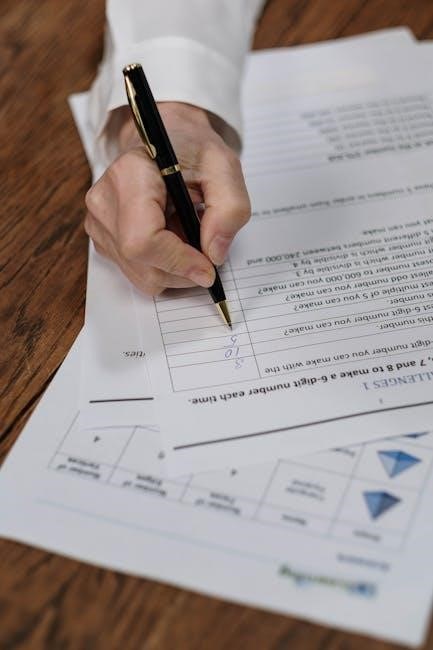Pronoun-antecedent agreement is a fundamental grammar rule ensuring pronouns correctly match their antecedents in number, person, and gender. It enhances clarity and effectiveness in communication, making writing precise and professional.
1.1 Definition of Pronoun-Antecedent Agreement
Pronoun-antecedent agreement refers to the grammatical rule that a pronoun must match its antecedent in number, person, and gender. The antecedent is the noun or pronoun to which the pronoun refers. For clear communication, the pronoun must align with its antecedent to avoid ambiguity. This rule ensures that sentences are grammatically correct and convey the intended meaning effectively. Proper agreement is essential for maintaining clarity and precision in writing and speech.
1.2 Importance of Pronoun-Antecedent Agreement in Grammar
Pronoun-antecedent agreement is crucial for clear and effective communication. It ensures that pronouns accurately reflect the nouns they replace, avoiding ambiguity and confusion. Proper agreement enhances the clarity and professionalism of writing, making it easier for readers to understand the intended meaning. Incorrect agreement can lead to misinterpretation, weakening the overall impact of the message. Mastering this rule is essential for producing grammatically correct and precise sentences, which are vital in both academic and professional contexts.
Key Rules of Pronoun-Antecedent Agreement
Pronouns must agree with their antecedents in number, person, and gender to ensure clarity and grammatical correctness in sentences.
2.1 Agreement in Number
Pronouns must match their antecedents in number. Singular antecedents require singular pronouns, while plural antecedents need plural pronouns. Examples include using “he” for a single male and “they” for a group. This rule ensures sentences are grammatically correct and clear, avoiding confusion. Worksheets often test this by providing sentences with underlined nouns, requiring students to select the correct pronoun. Mastery of number agreement strengthens writing and communication skills, making it a foundational concept in grammar.
2.2 Agreement in Person
Pronouns must also agree with their antecedents in person, which refers to first, second, or third person. For example, “he” (third person) cannot replace “I” (first person). This ensures consistency and clarity in sentences. Worksheets often include exercises where students identify correct pronouns based on person. Proper agreement avoids confusion, as using the wrong person can change the sentence’s meaning. Mastering this aspect enhances overall communication and grammar skills, making it essential for clear and accurate writing.
2.3 Agreement in Gender
Pronouns must align with their antecedents in gender, which can be masculine, feminine, or neuter. For example, “he” refers to masculine, “she” to feminine, and “it” to neuter. Worksheets often include exercises to practice this, such as replacing nouns with the correct gender-appropriate pronouns. Proper agreement in gender ensures clarity and avoids ambiguity, making the sentence more precise. It is essential for maintaining grammatical accuracy and effective communication in both writing and speech.

Common Errors in Pronoun-Antecedent Agreement
Common errors include mismatched number, incorrect gender, and ambiguity in antecedent reference. These mistakes can confuse meaning, emphasizing the importance of understanding and applying agreement rules correctly.
3.1 Singular vs. Plural Pronouns
A common error occurs when pronouns do not match their antecedents in number. For example, using they to refer to a singular noun like everyone is incorrect. Collective nouns like family can also cause confusion, as they are singular but often treated as plural. Additionally, indefinite pronouns such as someone or anyone are singular but are frequently paired with plural pronouns. Worksheets with answers help identify and correct these mistakes, ensuring proper agreement and clarity in writing.
3.2 Collective Nouns and Pronoun Agreement
Collective nouns, such as family or team, can be challenging in pronoun agreement. They are singular nouns but often refer to multiple individuals. For instance, the class is singular, so the pronoun it is correct, whereas plural pronouns like they are incorrect. However, when referring to the members of the group, plural pronouns may be appropriate. Worksheets with answers help clarify these distinctions, ensuring proper agreement and avoiding common mistakes in writing. Practice exercises focus on identifying correct pronouns for collective nouns in various contexts.
3.3 Indefinite Pronouns and Their Challenges
Indefinite pronouns, like someone, anyone, and everyone, present challenges in pronoun-antecedent agreement. They often refer to non-specific nouns, making it difficult to determine if they are singular or plural. For example, none can be treated as singular or plural, leading to confusion. Worksheets with answers help clarify these issues by providing exercises that test the correct use of pronouns with indefinite antecedents, ensuring proper agreement and reducing common errors in writing.

Pronoun-Antecedent Agreement Worksheets with Answers
Pronoun-antecedent agreement worksheets provide targeted exercises to practice and correct errors. Each worksheet includes answers, enabling self-assessment and mastery of grammar rules for all learners.
4.1 Basic Exercises for Beginners

Basic exercises for beginners focus on foundational concepts of pronoun-antecedent agreement. These worksheets introduce simple sentences where learners replace nouns with correct pronouns. Activities include identifying antecedents and selecting appropriate pronouns. Examples often involve singular and plural nouns, ensuring clarity and ease for new learners. Each exercise is followed by answers, allowing students to check their work and understand common mistakes. These resources are ideal for introducing the topic in a structured and accessible manner, building a strong grammar foundation for future learning.

4.2 Intermediate-Level Practice
Intermediate-level exercises challenge learners to apply pronoun-antecedent agreement in more complex sentences. These worksheets focus on scenarios involving collective nouns, indefinite pronouns, and sentences with multiple antecedents. Students practice identifying correct pronouns for tricky cases, such as “each” or “everyone,” and sentences where ambiguity may arise. Answer keys and explanations are provided to clarify common mistakes, helping learners refine their understanding and improve accuracy in their writing and communication skills.
4.3 Advanced Exercises for Mastery
Advanced exercises push learners to refine their skills in complex pronoun-antecedent scenarios. These worksheets focus on nuanced cases, such as ambiguous antecedents, collective nouns, and indefinite pronouns. Students tackle sentences with multiple clauses, ensuring pronouns align correctly with their intended references. Detailed explanations and answer keys are included to address common pitfalls and reinforce mastery. This level prepares learners for real-world writing challenges, solidifying their understanding of advanced grammar principles and improving overall communication clarity.

Solving Pronoun-Antecedent Agreement Problems
Solving these problems requires identifying the antecedent and ensuring the pronoun matches in number, person, and gender. Use strategies like underlining pronouns and their antecedents to clarify relationships and avoid ambiguity.
5.1 Identifying the Antecedent
Identifying the antecedent is the first step in ensuring pronoun-antecedent agreement. The antecedent is the noun or pronoun to which a pronoun refers. To find it, look for the word the pronoun replaces or describes. For example, in “Chris lost her notebook,” “Chris” is the antecedent of “her.”
When solving problems, underline or highlight the pronoun and its antecedent to clarify their relationship. This helps avoid confusion, especially in complex sentences. Always ensure the pronoun matches the antecedent in number, person, and gender for grammatical accuracy.
5.2 Selecting the Correct Pronoun
Selecting the correct pronoun involves matching it to the antecedent in number, person, and gender. For singular nouns, use pronouns like “he,” “she,” or “it,” while plural nouns require “they,” “we,” or “their.”
For example, “The boy lost his book” uses “his” to match “boy.” Collective nouns like “team” can take singular or plural pronouns, depending on context. Always ensure the pronoun aligns with the antecedent to maintain clarity and grammatical accuracy in sentences.
5.3 Avoiding Common Pitfalls
Common pitfalls in pronoun-antecedent agreement include mismatched number and gender. For example, using “their” instead of “his” for a singular male antecedent. Collective nouns like “team” can be tricky, as they may require singular or plural pronouns depending on context. Indefinite pronouns like “everyone” often cause errors, as they are singular but sometimes incorrectly paired with plural pronouns. Always double-check the antecedent and its number, gender, and person to ensure proper agreement and avoid confusion in sentences.

Answers and Explanations
This section provides correct answers and detailed explanations for each pronoun-antecedent agreement exercise, helping learners understand mistakes and master the concept effectively.
6.1 Correcting Common Mistakes
Common mistakes in pronoun-antecedent agreement often stem from incorrect number, person, or gender matching. For example, using they for a singular antecedent like everyone is a frequent error. To correct this, identify the antecedent’s number and person, then choose a pronoun that aligns with it. Collective nouns like team can be tricky—use singular pronouns if referring to the group as a whole, and plural if referring to individual members. Regular practice with worksheets helps reinforce these rules and reduce errors over time.
6.2 Detailed Explanations for Each Exercise
Detailed explanations for each exercise provide a thorough breakdown of correct answers, ensuring understanding of pronoun-antecedent agreement rules. Each explanation covers number, person, and gender agreement, with practical examples to illustrate correct usage. Complex cases, such as collective nouns and indefinite pronouns, are clarified with clear reasoning. Tips for avoiding common pitfalls are included, helping learners grasp nuanced concepts. These explanations serve as a comprehensive guide, reinforcing grammar principles and improving accuracy in future exercises.
6.3 Scoring Guide for Self-Assessment
The scoring guide provides a clear framework for evaluating progress in pronoun-antecedent agreement. It assigns points based on accuracy, with 90-100 indicating mastery, 80-89 showing strong understanding, 70-79 requiring minor improvement, and below 70 needing significant review. Detailed feedback highlights strengths and areas for focus, enabling learners to track growth. This guide helps users assess their performance objectively and identify specific skills to refine, ensuring targeted practice for better results.

Teaching Tips for Pronoun-Antecedent Agreement
Use interactive exercises and real-world examples to engage students. Provide immediate feedback and encourage self-assessment. Incorporate group activities to promote collaborative learning and reinforce grammar rules effectively.
7.1 Strategies for Effective Instruction
Effective instruction begins with clear explanations and examples. Use real-world scenarios to illustrate pronoun-antecedent agreement. Incorporate interactive activities, such as group work or role-playing, to engage students. Provide immediate feedback to correct misunderstandings. Utilize visual aids like charts or diagrams to simplify complex rules. Encourage students to identify and explain errors in sentences. Offer differentiated instruction to cater to varying learning levels. Use targeted worksheets to reinforce concepts and promote self-assessment. These strategies create a supportive and interactive learning environment.
7.2 Using Worksheets in the Classroom
Worksheets are essential for reinforcing pronoun-antecedent agreement skills. They provide targeted practice, allowing students to apply rules in structured exercises. Include answer keys for self-assessment and immediate feedback. Use worksheets to address specific challenges, such as singular vs. plural or collective nouns. Incorporate varying difficulty levels to cater to different learning needs. Regular use helps track progress and build confidence; Pair worksheets with class discussions to clarify doubts and deepen understanding. This structured approach ensures mastery of grammar concepts in an organized and engaging manner.
7.3 Encouraging Interactive Learning
Interactive learning enhances engagement and understanding of pronoun-antecedent agreement. Incorporate group activities, such as pair work or small group discussions, where students analyze sentences and identify correct pronouns. Use games or quizzes to make practice fun and competitive. Encourage peer teaching, where students explain their answers to others. Utilize digital tools like Kahoot! or online quizzes for real-time feedback. Role-playing exercises can also help students apply rules in real-life scenarios. Interactive approaches foster collaboration, critical thinking, and a deeper grasp of grammar concepts.

Pronoun-antecedent agreement is essential for clear and accurate communication. Mastering it enhances writing and speaking skills, ensuring precision and professionalism in all forms of expression.
8.1 Summary of Key Concepts
Pronoun-antecedent agreement ensures clarity and precision in communication by requiring pronouns to match their antecedents in number, person, and gender. Key concepts include understanding the relationship between pronouns and their referents, applying rules for singular and plural agreement, and avoiding common errors like mismatched indefinite pronouns. Worksheets provide practical exercises to master these skills, highlighting challenges with collective nouns and indefinite pronouns. Correct agreement enhances the professionalism and effectiveness of written and spoken language, making it a foundational grammar skill.
8.2 Final Tips for Mastery
To master pronoun-antecedent agreement, focus on identifying clear antecedents and avoiding ambiguity. Regular practice with worksheets helps reinforce number, person, and gender agreement. Start with basic exercises and gradually move to advanced ones. Use PDF resources for self-assessment and review common errors. Reading sentences aloud can help catch mismatches. Always ensure the pronoun clearly refers to its antecedent, especially with collective nouns and indefinite pronouns. Consistent practice and attention to sentence structure will build confidence and accuracy in pronoun usage.

Additional Resources
Explore PDF worksheets, guides, and online tools for additional practice. These resources offer comprehensive exercises and answers to help master pronoun-antecedent agreement effectively and efficiently.
9.1 Recommended Worksheets and Guides
For comprehensive practice, download PDF worksheets tailored for different skill levels. These guides include exercises on number, person, and gender agreement, with detailed answer keys. Many resources offer interactive exercises and printable formats, ideal for classroom or self-study. Some popular options include “Pronoun-Antecedent Agreement Workbook” and “Grammar Practice Worksheets.” These materials provide clear examples, ensuring learners grasp concepts easily and apply them correctly in sentences. They are perfect for reinforcing grammar fundamentals and improving writing accuracy.
9.2 Online Tools for Further Practice
Enhance your skills with online tools offering interactive exercises and quizzes. Websites like Khan Academy, Grammarly, and specific grammar-focused platforms provide engaging resources. Many offer immediate feedback, progress tracking, and detailed explanations. Interactive exercises allow users to practice identifying antecedents and selecting correct pronouns in real-time. Additionally, some tools feature games and adaptive learning to cater to different learning styles. These resources complement traditional worksheets, making practice dynamic and accessible for learners of all levels.
